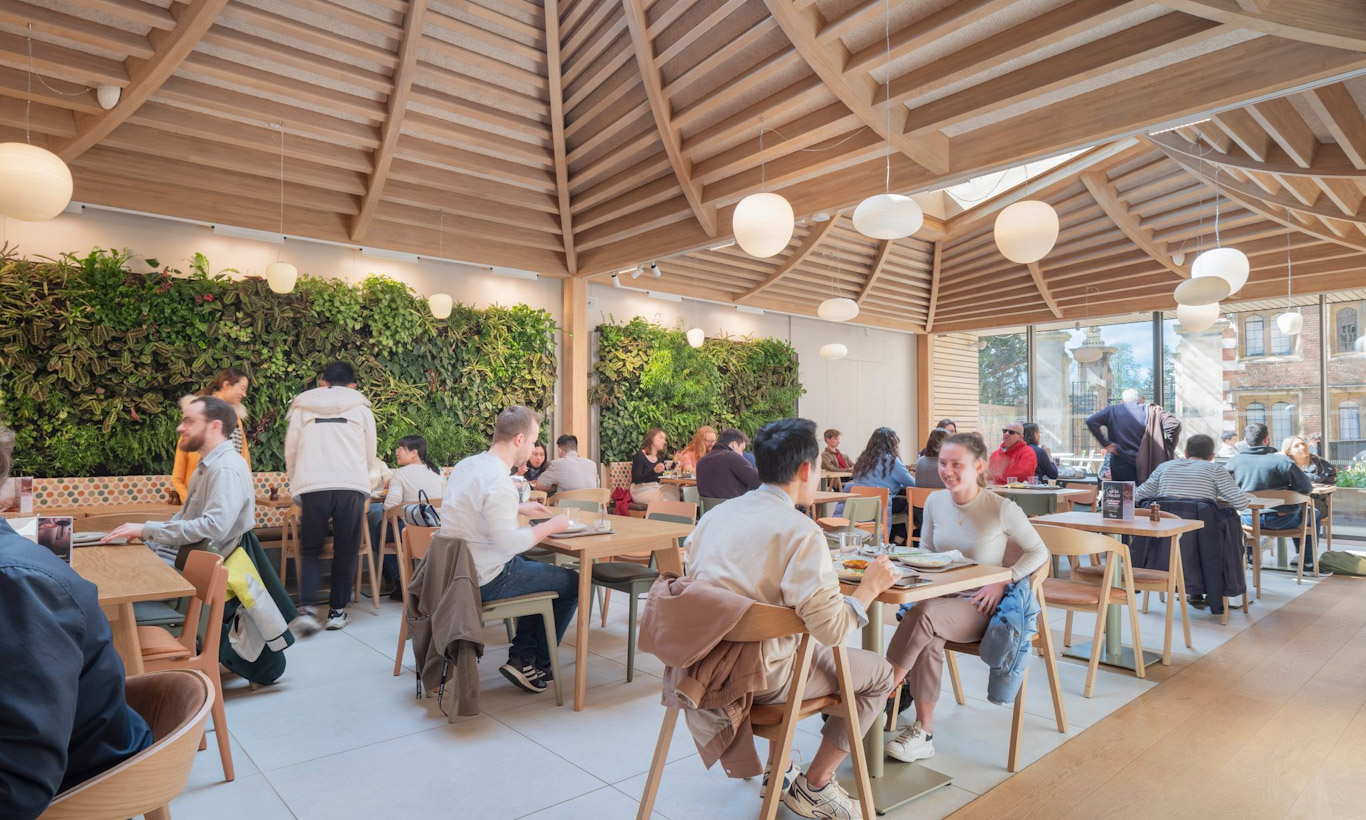Cambridge-based architects MCW have completed work on a new cluster of social spaces at the heart of St John’s College, Cambridge, transforming a 500-year-old tradition of community dining on the site in line with contemporary tastes.
Alongside a new bar and a completely rebuilt buttery dining room is a café – a first for the college since its foundation in 1511. The new social spaces aim to fuse the contemporary need for an airy and vibrant social hub and eatery for students and academics alike, using modern construction methods and contemporary material choices, with the need to preserve a sense of history and character.
A comprehensive Masterplan Strategy had set out a series of aspirational objectives in 2017, underpinned by the notion of strengthening the College community. This project represents the first major step in response to a recognised need to provide an inclusive, supportive and energising social space at the centre of the campus.
This brief was met by a creative and thoughtful team of architects and planners, led by MCW with Purcell, Turley Planning Consultants, Tobit Curteis Associates and KJ Tait. The project has been an ongoing collaboration with Historic England and the Cambridge City Council Planning and Conservation group. Turner & Townsend project managed the scheme from design stage to completion, with Barnes Construction as the main contractor.
The most significant element of the scheme is the new glulam oak superstructure of the buttery dining room, chosen because of its inherent warmth and tactile quality- reflecting the original oak columns and beams within the bar and cafe, as well as its low carbon credentials and potential to be assembled as a kit of parts.
The new structure, a collaboration with Swiss timber specialists Blumer Lehmann and local structural engineers Smith and Wallwork, is ‘free-standing’ with only minimal, delicate stainless-steel ties back to the original brickwork, replaces a 1970’s steel-framed roof that had been brutally built into the 16th century brickwork of both the Second Court building and the boundary wall to Trinity College.
The dramatic curved, trapezoidal timber structure, formed of prefabricated components, was brought on site across what is reputed to be the second oldest bridge over the Cam – designed by Christopher Wren and executed by Robert Grumbold – who also built the pair of Grade I listed, eagle-topped gate piers which had to be completely dismantled and carefully relocated as part of the project. Gaining approval to dismantle and rebuild Grade I listed fabric was one of the many challenges that the design team overcame.
The MCW team worked hard to preserve a character authentic to St John’s, taking a ‘fabric-first’ approach to construction, which protects the integrity, stability and condition of historic fabric, whilst also boosting energy efficiency and carbon reduction. This meant retaining the building’s signature red brick and centuries-old wood panelling – whilst also incorporating elements that promote energy efficiency and health and wellbeing, including a ‘green wall’ watered by collected rainwater from the carefully detailed pre-patinated copper roof.
The social spaces sit within a site that includes the Grade I listed Second Court which has been continuously used as part of College accommodation since it was constructed in 1599. The surrounding park and gardens are Grade II* listed. Therefore, a comprehensive heritage impact assessment was critical to unlocking the potential for change to enable the site to continue to evolve, bringing relevance for a new era without harming the historic integrity of the building.
Purcell worked as Conservation Architect for the existing building, upgrading the environmental performance and repairing the fabric as well as working collaboratively with MCW on the interface between old and new to develop a solution that would touch the historic fabric as lightly as possible, outlining areas where change was possible without causing unnecessary harm.
A trophy cabinet has been made within a historic window that was discovered behind 18th century panelling during the works. Original window seats have been carefully reconstructed incorporating power-points for laptops.
Improving inclusivity and accessibility was a primary component of the brief. A careful re-grading within Second Court has created a level access where stone steps used to be and a new ramp alongside the terrace does the same for people approaching from the ‘Backs’, on Queen's Road.
Despite the challenges of preserving historic detail and meeting the complex demands of development within and around a Grade I listed building, the project achieved a BREEAM Excellent rating: a sustainability assessment method for projects and buildings.
Paula Mejia-Wright, Project Lead for MCW, explains: “The application of contemporary retrofitting into historic settings is going to be crucial for colleges to thrive beyond the 21st Century. With collaborative design work, we have been able to re-energise an important part of the College, creating a sustainable and elegant meeting place for the whole college community.”
Heather Hancock, Master of St John’s, said: “We have gained bright, warm and welcoming space for our day-to-day lives in College. We are privileged to learn, live and meet in such a beautiful and inspiring environment, and this latest development is a worthy addition to the fabric of the College.”


